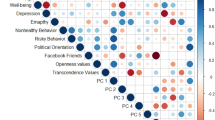Abstract
Using 14 personality measures obtained while the subjects were in medical school, the resulting profiles of 972 physicians were clustered into five groups using a two-stage cluster analysis procedure. Subjects were followed over a 30-year period to determine the cumulative survival rate (proportion of subjects remaining free of cancer) in each group. Statistically significant group differences in survival rate were found, with the group characterized by acting out and emotional expression having the most favorable curve (less than 1% developing cancer). The group characterized as “loners,” who may well have suppressed their emotions, had the most unfavorable survival curve and was 16 times more likely to develop cancer than was the group characterized by acting out and emotional expression.
Similar content being viewed by others
References
Bacon, C. L., Renneker, R., and Cutler, M. (1952). A psychosomatic survey of cancer of the breast.Psychosom. Med. 14: 453.
Bahnson, M. B., and Bahnson, C. B. (1969). Ego defenses in cancer patients.Ann. N. Y. Acad. Sci. 164: 546–559.
Blumberg, E. M., West, P. M., and Ellis, F. W. (1956). MMPI findings in human cancer. In Welsh, G. S., and Dahlstrom, W. C. (eds.),Basic Readings on the MMPI in Psychology and Medicine, University of Minnesota Press, Minneapolis.
Fox, B. H. (1978). Premorbid psychological factors as related to cancer incidence.J. Behav. Med. 1: 45–133.
Glaser, R., Kiecolt-Glaser, J. K., Speicher, C. E., and Holliday, J. E. (1985). Stress, loneliness, and changes in herpes virus latency.J. Behav. Med. 8: 249–260.
Graves, P. L., and Thomas, C. B. (1981). Themes of interaction in medical students' Rorschach responses as predictors of midlife health or disease.Psychosom. Med. 43: 215–225.
Graves, P. L., Mead, L. A., and Pearson, T. A. (1986). The Rorschach Interaction Scale as a potential predictor of cancer.Psychosom. Med. 48: 549–563.
Greer, S., and Morris, T. (1975). Psychological attributes of women who develop breast cancer: A controlled study.J. Psychosom. Res. 19: 147–153.
Kaplan, E. L., and Meier, P. (1958). Nonparametric estimation from incomplete observations.J. Am. Stat. Assoc. 53: 457–481.
Kissen, D. (1963). Personality characteristics in males conducive to lung cancer.Br. J. Med. Psychol. 36: 27–36.
Kissen, D. (1966). The significance of personality in lung cancer in men aged 55–64.Ann. N. Y. Acad. Sci. 175: 820–826.
LeShan, L. (1966). An emotional life-history pattern associated with neoplastic disease.Ann. N. Y. Acad. Sci. 125: 780–793.
Milligan, G. W., and Sokol, L. M. (1980). A two-stage clustering algorithm with robust recovery characteristics.Educ. Psychol. Meas. 40: 755–759.
Romesburg, H. C. (1984).Cluster Analyses for Researchers, Lifetime Learning, Belmont, Calif.
Shaffer, J. W., Duszynski, K. R., and Thomas, C. B. (1982a). Family attitudes in youth as a possible precursor of cancer among physicians: A search for explanatory mechanisms.J. Behav. Med. 5: 143–163.
Shaffer, J. W., Duszynski, K. R., and Thomas, C. B. (1982b). Youthful habits of work and recreation and later cancer among physicians.J. Clin. Psychol. 38: 893–900.
Shaffer, J. W., Graves, P. L., Mead, L. A., Thomas, C. B., and Pearson, T. A. (1986). Development of alternate methods for scoring the Rorschach Interaction Scale.Educ. Psychol. Meas. 46: 837–844.
Stavraky, K. M., Buck, C. W., Lott, S. S., and Wanklin, J. M. (1968). Psychological factors in the outcome of human cancer.J. Psychosom. Res. 12: 251–259.
Syme, S. L. (1984). Sociocultural factors and disease etiology. In Gentry, W. D. (ed.),Hand-book of Behavioral Medicine, Guilford Press, New York.
Thomas, C. B. (1977).Habits of Nervous Tension: Clues to the Human Condition, The Precursors Study, Baltimore, Md.
Trunnell, J. B. (1952).Second Report on Institutional Research Grants of the American Cancer Society, American Cancer Society, New York.
Author information
Authors and Affiliations
Additional information
This research was supported by National Cancer Institute Grant CA-24416, National Institute on Aging Grant AG-01760, and The Johns Hopkins University School of Medicine.
Rights and permissions
About this article
Cite this article
Shaffer, J.W., Graves, P.L., Swank, R.T. et al. Clustering of personality traits in youth and the subsequent development of cancer among physicians. J Behav Med 10, 441–447 (1987). https://doi.org/10.1007/BF00846143
Accepted:
Issue Date:
DOI: https://doi.org/10.1007/BF00846143




